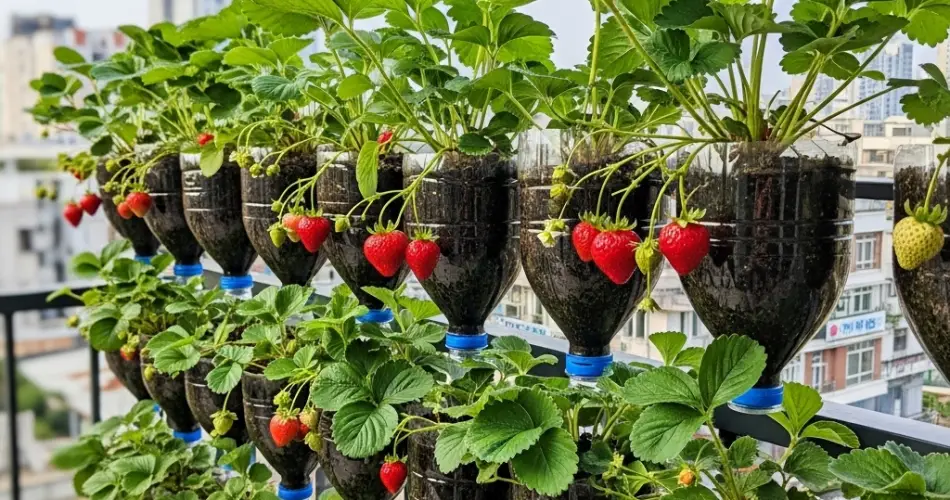Growing strawberries in plastic bottles is a practical and creative solution for gardeners who are short on space but still crave the joy of harvesting sweet, homegrown berries. With a few recycled containers, basic tools, and the right techniques, you can establish a thriving strawberry garden right on your balcony, windowsill, or backyard wall.
This method is not only space-efficient but also eco-friendly, as it gives new life to discarded plastic bottles. Whether you’re a seasoned gardener or just starting out, cultivating strawberries in bottles is a fun and fruitful way to enjoy fresh berries at home.
Why Grow Strawberries in Bottles?
Strawberries are compact, shallow-rooted plants, making them perfect candidates for container gardening. Growing them vertically in bottles offers several benefits:
-
Space-saving: Utilize vertical surfaces like fences, walls, or railings.
-
Recycling: Reduce plastic waste by repurposing bottles into planters.
-
Easy care: Bottles keep berries off the ground, reducing pest and disease risks.
-
Aesthetic: Vertical strawberry gardens look attractive and decorative.
Materials Needed
To set up your strawberry bottle garden, gather the following materials:
-
Empty plastic bottles (2-liter or 1.5-liter sizes work well)
-
Sharp cutter or utility knife
-
Heated nail or drill for drainage holes
-
Potting soil rich in organic matter
-
Compost or well-rotted manure
-
Strawberry seedlings (bare-root or potted)
-
Twine or wire (if hanging)
-
Marker for cutting guides
Preparing the Bottles
-
Clean and Dry: Wash the bottles thoroughly to remove labels and residues.
-
Cut Openings: Create horizontal or vertical slits along the bottle’s body. Each slit should be around 5–7 cm wide—large enough to insert the strawberry plants.
-
Drainage: Poke multiple holes in the bottom of each bottle to allow excess water to drain.
-
Vertical Mounting: You can hang bottles using twine or attach them to a wall or wooden frame for easy access and sunlight exposure.
Filling the Bottles
Strawberries thrive in well-draining, fertile soil. Create a mixture of:
-
60% potting soil
-
30% compost or aged manure
-
10% sand or coco peat for aeration
Fill each bottle with the mix, lightly pressing it down to remove air pockets. If you’re using vertical bottle stacks, make sure the soil is firm enough to support the weight of the plants.
Planting the Strawberries
Choose strawberry varieties suitable for containers, such as day-neutral or everbearing types. These provide continuous fruiting and adapt well to limited space.
-
Insert Seedlings: Gently place the seedlings into the bottle slits. Ensure that the crown (where leaves meet the roots) sits just above the soil surface.
-
Firm the Soil: Lightly press the soil around the roots to secure the plant.
-
Water Immediately: Moisten the soil thoroughly after planting.
For bottles placed vertically on the ground, plant one seedling per bottle. For horizontally positioned bottles with side openings, you can plant 2–3 seedlings per container.
Sunlight and Placement
Strawberries need at least 6 hours of direct sunlight each day. Place the bottles in a sunny location—on a balcony railing, wall-mounted rack, or hanging frame. Rotate hanging bottles occasionally to ensure even light exposure.
If growing indoors, position bottles near a south-facing window or supplement with grow lights.
Watering and Fertilizing
Plastic bottles dry out faster than traditional garden beds, so consistent watering is crucial. Check the soil daily, especially during warm weather, and water when the top 2 cm feels dry.
Every 2–3 weeks, feed the plants with a balanced liquid fertilizer or diluted compost tea. Strawberries are heavy feeders during flowering and fruiting, so keep them nourished.
General Maintenance
-
Mulch: Add a layer of straw or shredded leaves around the base of the plants to retain moisture and keep fruits clean.
-
Remove Runners: Pinch off runners (long shoots) if you want to focus the plant’s energy on fruit production.
-
Pest Monitoring: Bottle gardens are less prone to soil-borne pests, but check leaves for aphids or mites.
Harvesting Strawberries
Strawberries are ready to harvest when they turn fully red, plump, and fragrant. Gently twist the fruit from the stem to avoid damaging the plant. Regular picking encourages more fruit production.
Harvest in the morning when the berries are cool and firm for the best flavor and shelf life.
Replanting and Seasonal Care
Strawberry plants typically produce well for 2–3 years. After that, their yield declines. You can propagate new plants by rooting healthy runners in soil or water, then transplanting them into fresh bottles.
At the end of the season, trim back old leaves, refresh the soil, and prepare for the next growing cycle.
Conclusion
Growing strawberries in plastic bottles is an ingenious way to enjoy fresh fruit even in tight living spaces. With a little preparation and care, you can transform everyday waste into productive planters and enjoy homegrown strawberries straight from your wall or window.
Whether you’re looking to reduce your food miles or just want a splash of sweetness in your home garden, bottle-grown strawberries offer a delightful, rewarding experience for all gardening levels.



